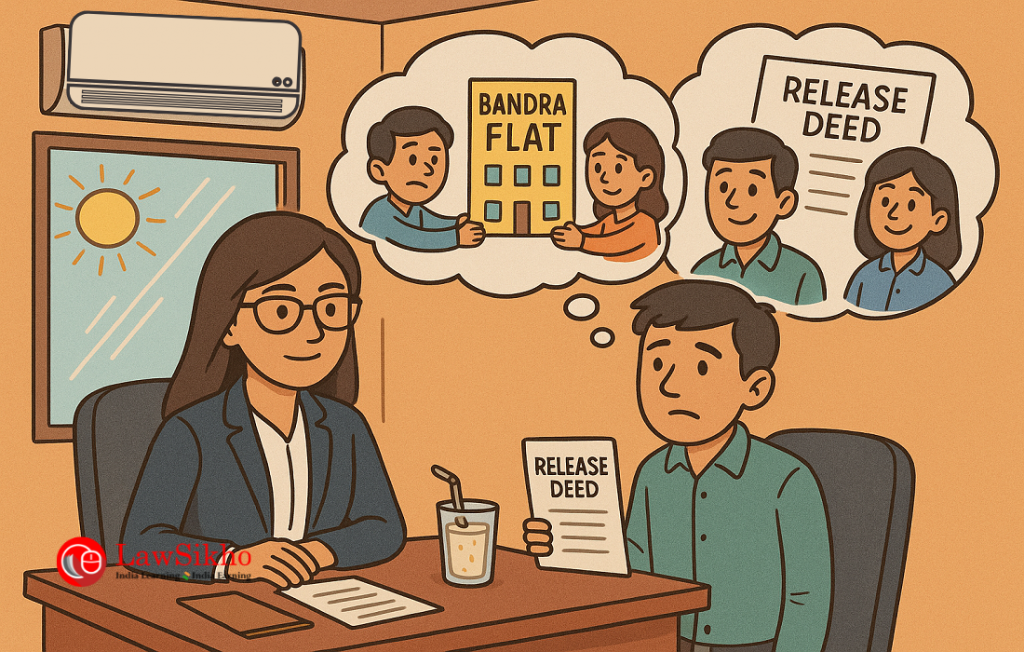This article will help you understand the core concepts, key components, and a step-by-step drafting process of a release deed. Whether you are a fresher or an advocate looking to learn about a release deed, this article will equip you with everything you need to know.
Table of Contents
Introduction
It is April 2024, and Mumbai’s summer is at its peak. My office turned into a sauna despite the air conditioner.
I was halfway through my chilled lassi, dreaming of going to a hill station, when my phone buzzed. It was my client Rohan Tejpal.
He told me that his family is fighting over his dad’s old Bandra flat and asked me to help resolve the issue. I told him to come to my office in the evening.
I have handled a fair share of inheritance disputes, and I knew where they would lead.
As usual, Rohan arrived on time, but he looked worried. I offered him coffee and made him sit in my cabin. Then he narrated the entire issue at length.
In short, the issue was that his father passed away in 2024, leaving behind a flat at Bandra. Rohan had two siblings, and each of them inherited a 1/3rd share in the flat. Now, one of the siblings wants to give away her share to the other two to avoid any legal disputes in the future.
I suggested that we go for a release deed. I explained the pros and cons to him. He was convinced and asked me to proceed and draft the release deed.
So, today, we will learn about the core concept of the release deed. Most importantly, I will guide you through the drafting process of a release deed.
Are you ready? Let us start.
What is a release deed?
A release deed or deed of release is a legal document where one party (the releasor) voluntarily surrenders their rights, claims, or interests in a property or asset to another party (the releasee).
It can involve any parties, related or not, and it can be made with or without consideration.
But you might wonder how it is different from a gift deed
Let us find out.
What is the difference between a gift deed and a release deed?
| Criteria | Gift Deed | Release Deed |
| Definition | In a gift deed, a donor transfers the ownership of a property to a donee out of their natural love and affection. | In a release deed, a releasor surrenders rights or claims to a property or asset to a releasee, with or without consideration. |
| Consideration | It is always made without consideration | It is made with or without consideration |
| Scope | The scope is limited to movable and immovable properties | The scope is wide enough to cover different transactions and not just transactions relating to immovable properties. |
| Transfer of ownership | In a gift deed, the absolute ownership of the property has to be transferred to the donee. | In a release deed, the release varies from case to case. But partial release of the share in the property is permissible. |
There are different use cases for a release deed. Let us understand it.
What is the purpose of a release deed?
The first purpose is to settle the disputes among the legal heirs of a deceased person.
For instance, after Mr. D passes away, he leaves behind a house that will be inherited equally by his three children, viz. A, B and C. Now C lives abroad and has no intention of claiming a share in the property. So to keep things simple and avoid future legal battles, C can execute a release deed in favour of A and B, releasing his 1/3rd share in the house in favour of A and B.
Now you know why I suggested that my client Rohan execute a release deed for this inheritance issue.
The second purpose is to resolve the issue between co-owners of a property.
Imagine that A and B are friends who jointly bought a flat in Pune, thereby each of them owns a 50 % share in the flat. After a few years, A decides to relocate permanently to another city and no longer wants to be involved with the flat. Therefore, instead of selling the property or going to the court, A can release his 50% share in the flat to B through a release for a consideration amount of Rs 25 lakhs. With this transaction, B becomes the sole owner and A gets his money.
The third purpose is to resolve the disputes that arise between partners carrying on business together.
For instance, A and B started a cafe together in Mumbai as equal partners. After a couple of years, B decides to step away from the business to pursue another opportunity. To avoid future complications or profit claims, B can sign a release deed in favour of A, stating that he is giving up all his rights, interests, and claims in the cafe, including profits, liabilities, and goodwill. A may even pay an amount of Rs.15 lakhs to B for his share.
The next purpose is for settling debts.
For instance, A owes B Rs.5 lakhs for a personal loan. Due to financial constraints, A and B agree to settle the debt for Rs.3.5 lakhs. To formalise this, B signs a release deed, confirming that once A pays the Rs.3.5 lakhs, B will not claim the remaining Rs.1.5 lakhs in the future. This deed ensures that A is free from any further claims or harassment related to the remaining Rs.1.5 lakhs, and B has no right to demand more money.
The last purpose is for terminating employment without any legal problems
Imagine that A works for B’s software company in Bangalore. After a restructuring, A is laid off, but A is given a severance package. To avoid future disputes or lawsuits, both A and B sign a release deed. In this document, A acknowledges receipt of all dues (severance, bonuses, etc.), and B confirms that neither party will make any further claims. This ensures that A cannot sue for wrongful termination or other employment related claims in the future.
Therefore, in India, a release deed serves as an important legal document for resolving family disputes, simplifying inheritance, and settling business liabilities, often without monetary consideration, especially among relatives.
Is registration of a release deed mandatory?
If a release deed is executed in respect of an immovable property having a value of Rs.100 or above, it is mandatory to be registered under section 17(1)(b) of the Registration Act,1908
After it is registered, it becomes a legally enforceable document in the eyes of law.
In all other cases, it is not required to register a release deed.
Let us examine the consequences of not registering a release deed.
What are the effects of non-registration of a release deed?
Now that we know registration of a release deed in respect of an immovable property is mandatory, let’s explore what happens if you skip it.
- First, an unregistered release deed is inadmissible in court. According to section 49 of the Registration Act, 1908, it cannot be used to enforce rights in respect of the immovable property in the event of a dispute arises between the parties and it cannot be used in evidence of any transaction affecting such property.
- Second, the non-registration of the release deed invites the risk of dispute from the parties as well as third parties, such as heirs or creditors, who could challenge the transfer, claiming that the property still belongs to the releasor.
- Third, there is no public record of the deed. On the other hand, a registered deed is available with the Sub-Registrar for verification of the execution of the deed.
In short, an unregistered release deed could allow future claims to haunt the person accepting the release in their favour.
What are the stamp duty and registration charges of a release deed in India?
The stamp duty and registration charges differ from State to State.
In Maharashtra, if a release deed is executed in respect of an ancestral property between the heirs, then as per Article 52 of the Maharashtra Stamp Act, the stamp duty will be Rs.500/- and the registration charge will be Rs.1,000/-.
In case a release deed is executed in respect of other property, then as per Article 52 of the Maharashtra Stamp Act, the stamp duty will be 6% (5% stamp duty + 1% metro cess) and the registration charge will be 1% of the value of the property or Rs.30,000/-, whichever is lower.
Therefore, before suggesting the remedy of executing a release deed, kindly check the stamp duty and registration charges in your respective States.
What are the key components of a release deed?
Key components will help you draft your release deed better, as you will be aware of what needs to be included. Let’s examine these key components.
- Title and opening clause
This is the introductory section that identifies the document as a “Deed of Release,” specifies the date and place of execution, and introduces the parties involved, viz., releasor and releasee, with their names, addresses, and a legal phrase extending the terms to their heirs, executors, and administrators. It sets the legal context and scope.
- Recitals
These clauses, starting with “WHEREAS,” provide the background story, detailing how the releasor acquired the property, their relationship with the releasees, and their intent to release their share of the property. They establish the context and justify the transfer.
- Release clause
The core of the deed, this clause legally transfers the releasor’s rights, title, and interest in the property to the releasees, stating whether it’s with or without consideration. It ensures the releasees gain a clear title.
- Covenant against encumbrances
The releasor warrants that they have not taken any action (e.g., created liens or debts) that would prevent the transfer, ensuring the releasees receive a clear title.
- Covenant of cooperation
The releasor agrees to execute additional documents or appear before authorities to perfect the releasee’s title, ensuring future compliance with legal or society requirements.
- Confirmation of releasees’ rights
This clause confirms that the releasees now hold the relinquished share, specifying their new ownership status, such as co-owners, and their rights to the property.
- Description of property
A detailed description of the property, including its address, size, survey numbers, society shares, and any associated rights, is included, often in a separate schedule. This ensures clarity and prevents disputes over what is being transferred.
- Signature and witnesses
The deed concludes with signatures of the releasor and releasees, witnessed by at least two individuals, to validate execution and ensure legal enforceability.
Now that you know the components, let us draft the release deed.
How to draft a release deed?
I will take the following example to draft a release deed.
Example: Neha Ram Khemlani, the Releasor, is the mother of Sonu and Rajesh Ram Khemlani, the Releasees. She is the owner of a residential flat bearing No. 417B in Morrison Cresent Co-operative Housing Society at Breach Candy, Mumbai, along with 10 society shares, which she had purchased through a registered sale deed in 2005. As she is financially secure and well-settled, she has decided to release her 50% undivided share in the said property in favour of her sons.
Explanation of the clauses has been given in red.
Explanation: The opening sentence describes the nature of the document being made and also mentions when and where the deed is being made and executed between the parties. This also introduces the Releasor (this means the person who is releasing or relinquishing his/her right in the property) and Releasee (this means the person in whose favour such right in the property is being released or relinquished). It shall contain the name and address of the parties. The phrase “which expression ………. and administrators” means that the term releasor and releasee shall extend to the legal heirs or successors unless it is otherwise provided for.
THIS DEED OF RELEASE made at Bombay this 15th day of April, 2025 made between NEHA RAM KHEMLANI residing at 417B, Morrison Cresent, Breach Candy, Neapensea Road, Mumbai-400006 hereinafter referred to as the “RELEASOR” (which expression shall unless it be repugnant to the context or meaning thereof be deemed to mean and include her heirs, executors and administrators) of ONE PART
AND
(1) SONU RAM KHEMLANI AND (2) RAJESH RAM KHEMLANI both of Bombay Indian Inhabitants residing at Flat No.1412, 14th Floor, Dalal Tower, Cuffe Parade, Colaba, Mumbai-400 005 hereinafter referred to as the “RELEASEES” (which expression shall unless it be repugnant to the context or meaning thereof be deemed to mean and include their respective heirs, executors and administrators) of OTHER PART
Explanation: You then start writing what is known as recitals. The recitals begin with “Whereas”, and it provides the background, explaining the history of how the property was acquired and the intention of the parties to transfer the property. You give full details of the property.
WHEREAS by and under the registered instrument of sale deed dated 14th May 2005, registered under Serial No.ABE-2/05832/2005 [A copy of Index – II annexed hereto], the RELEASOR herein acquired from one M/s. M.P.Realtors Pvt Ltd, therein referred to as the Transferor, the right, title and interest of the Transferor in (i) 417B, admeasuring about 1037 sq.ft. (carpet area) equivalent to 96.38 sq.mtrs. (built up area) or thereabouts on the 4th floor of the building known Morrison Cresent Co-operative Housing Society Ltd(hereinafter referred to as “the said society”) situate at Breach Candy, Neapensea Road, Mumbai-400006, (hereinafter referred to as “the said flat”) togetherwith 10 fully paid up shares of the said society of Rs.50/- each bearing distinctive nos.751 to 760 (both inclusive) under Certificate no.166 dated 23rd September 2001 issued by the said society (hereinafter referred to as “the said shares”) togetherwith all the other right, title and interest of the Transferor in the said society (the said flat, the said shares and the said other right, title and interest of the said Transferor in the said society are hereinafter referred to as the “the said property”) as more particularly described in the schedule hereunderwritten.
Explanation: This clause confirms that the Releasor has acquired full rights in the said property
AND WHEREAS in the premises aforesaid, the RELEASOR acquired 100% undivided right, title and interest in the said property.
Explanation: This clause shows the relation between the Releasor and the Releasees.
AND WHEREAS the RELEASOR is the mother of RELEASEE NO.1 and RELEASEE NO.2 and they are in the blood relations of each other.
Explanation: This clause clarifies the intention of the Releasor to release her share in the property in favour of her children.
AND WHEREAS the RELEASOR, who is well placed in life has expressed her desire to release her said 50% undivided right, title and interest in the said property in favour of RELEASEES, who are the children of the RELEASOR, on the terms and conditions mentioned hereinbelow.
Explanation: This marks the beginning of the operative clauses of the deed between the parties. These clause forms the integral part of the deed, which includes terms such as rights over property, future co-operation etc.
NOW THIS DEED OF RELEASE WITNESSETH AND IT IS HEREBY AGREED BY AND BETWEEN THE PARTIES AS FOLLOWS:-
Explanation: This forms the heart of the deed as it provides for the legal transfer of the share to the other person through release. It ensures that the persons who shall receive the property shall have a clear title to the property. The release can be with or without consideration, depending on the terms agreed between the parties.
1. The RELEASOR doth hereby renounce, release and relinquish her 50% undivided right, title and interest in the said property more particularly described in the Schedule hereunderwritten and all the rights, benefits and privileges directly and/or indirectly attached to the said property in favour of the RELEASEES without any consideration to the end, intent and purposes that the RELEASOR’S said 50% undivided right, title and interest in the said property shall hereafter vest in and belong to the RELEASEES to the exclusion of all persons claiming under her.
Explanation: This clause explains that the Releasor has not done any act which prevents her from transferring her share in the said property in favour of the Releasees.
2. The RELEASOR doth hereby covenant with the RELEASEES that she i.e. the RELEASOR has not done any acts, deeds, matters or things, whereby or by virtue of which she the said RELEASOR is prevented from releasing her 50% undivided right, title and interest in the said property in favour of the RELEASEES as herein sought.
Explanation: This clause states that the Releasor shall execute the necessary documents that will be necessary for the purpose of transferring the share in the said property in favour of the Releasees.
3. The RELEASOR shall and will from time to time and at all times hereinafter at the reasonable request and cost of the RELEASEES do execute all necessary instruments, papers and documents that may be deemed necessary in the opinion of the RELEASEES for effectively transferring and/or vesting her said 50% undivided right, title and interest in the said property exclusively in the name of the RELEASEES.
Explanation: This clause confirms that the Releasees are now entitled to a 50% share in the said property.
4. The RELEASOR confirms that now the RELEASEES are entitled to 50% right, title, interest and possession of the said property as the co-owners thereof.
Explanation: This clause mentions that the Releasee is now entitled to deal with the said property as a co-owner thereof.
5. That the RELEASEES as such co-owners are hereafter entitled to deal with and/or dispose of the said property in the manner that the RELEASOR AND RELEASEES deem fit.
Explanation: This part provides the detailed description of the property to be transferred including all rights, title and interest in respect of the said property.
THE SCHEDULE ABOVE REFERRED TO:
50% Undivided right, title and interest in 417B, admeasuring about 1037 sq.ft. (carpet area) equivalent to 96.38 sq.mtrs. (built up area) or thereabouts on the 4th floor of the building known Morrison Cresent Co-operative Housing Society Ltd (hereinafter referred to as “the said society”) situate on the plot of land bearing C.S No.619 at Breach Candy, Neapensea Road, Mumbai-400006, togetherwith 10 fully paid up shares of the said society of Rs.50/- each bearing distinctive nos.751 to 760 (both inclusive) under Certificate no.166 dated 23rd September 2001 issued by the said society and other right, title and interest of the RELEASOR in the said Morrison Cresent Co-operative Housing Society Ltd. situate at at Breach Candy, Neapensea Road, Mumbai-400006
Explanation: This signifies that the partners to the deed have acknowledged and accepted the terms by signing this deed.
IN WITNESS WHEREOF the parties hereto have hereunto set and subscribed their respective hands to this writing the day and the year first hereinabove written.
SIGNED AND DELIVERED )
by the withinnamed “RELEASOR” )
NEHA RAM KHEMLANI )
in the presence of ……… )
SIGNED AND DELIVERED by the )
withinnamed “RELEASEES” )
(1) SONU RAM KHEMLANI AND )
(2) RAJESH RAM KHEMLANI )
in the presence of ……… )
This was easy, right?
Once you become familiar with the basics and key components of a release deed, drafting one becomes relatively straightforward.
It is a practical skill, and once you master it, it can open up new income opportunities for you.
Conclusion
Now that you understand what a release deed is, along with its components and drafting steps, you are equipped to draft one yourself and assist your clients in resolving any property issues..However, it is always advisable to take sufficient time to draft a comprehensive deed tailored to meet the specific needs of the clients.






 Allow notifications
Allow notifications
